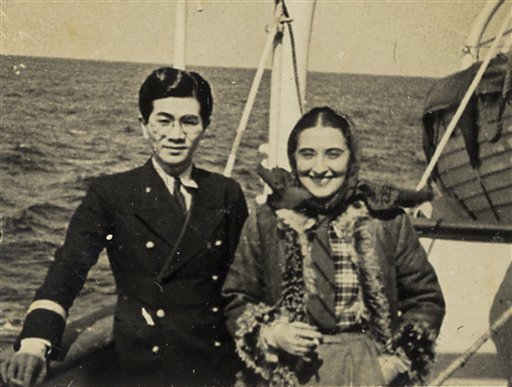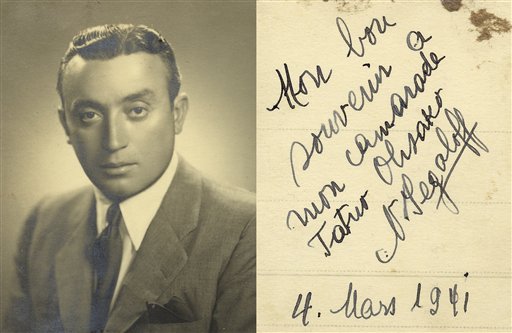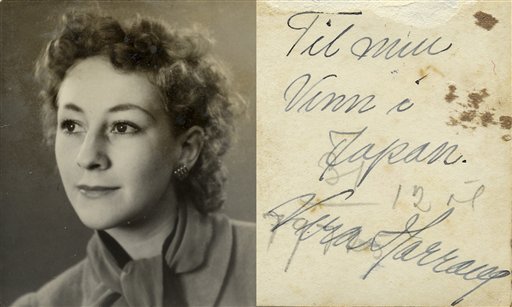 Tokyo – The young man’s monochrome portrait is at least 70 years old, the whites all faded to yellow, but it is still clear he had style. His hair is slicked down, eye arched, suit perfect with matching tie and handkerchief.
Tokyo – The young man’s monochrome portrait is at least 70 years old, the whites all faded to yellow, but it is still clear he had style. His hair is slicked down, eye arched, suit perfect with matching tie and handkerchief.
Subscribe to our Daily Roundup Email
He also had the good fortune to escape Europe in the early days of World War II. The photo, a gift to the man who helped him escape, is one of seven recently discovered snapshots that cast light on a little known subplot of the war – even as Germany sought to seal Jewish Europeans in, a small army of tourism officials from its main ally, Japan, helped shepherd thousands away to safety.
“My best regards to my friend Tatsuo Osako,” is scrawled in French on the back of the picture, which is signed “I. Segaloff” and dated March 4, 1941. His fate is unknown.
An effort is under way to find the people in these portraits or their descendants, all of whom are assumed to be Jewish. Personal photos of such refugees, who often fled with few possessions, are rare.
The photos were found in an old diary owned by Osako, who was a young employee of the Japan Tourist Bureau at the time, and died in 2003. Akira Kitade, who worked under Osako and is researching a book about him, has contacted Israeli officials for help and visited the United States Holocaust Memorial Museum in Washington, D.C.
The museum said he gave it about 30 photographs that he is trying to identify, and received a list of over 2,000 Jews who received travel papers that enabled them to reach Japan.
Nissim Ben Shitrit, the Israeli ambassador to Japan, says he has passed on the information to Yad Vashem in Jerusalem, which tracks and honors victims of the Holocaust, and is optimistic some of the individuals can be tracked down.

“I thought that we discovered almost everything about the horror of the Holocaust,” Shitrit said. “And yet there is more to discover.”
The photos shed further light on the story of Chiune Sugihara, a Japanese diplomat stationed in Lithuania who granted transit visas to several thousand Jews in the early days of the war. In doing so, he defied strict stipulations from Tokyo that such recipients have proper funds and a clear final destination after Japan.
He was one of a handful of diplomats such as Sweden’s Raoul Wallenberg and Hiram Bingham IV of the U.S. who used their bureaucratic machinery, often without their government’s knowledge, to issue the paperwork that would get Jews to safety.
Dubbed the “Japanese Schindler,” Sugihara was honored in 1985 by Yad Vashem as one of the Righteous Among the Nations, a high honor reserved for non-Jews who saved Jews at their own personal risk from the Holocaust, Hitler’s destruction of 6 million Jews.
A short movie about him, “Visas and Virtue,” won an Academy Award in 1997. Museums at his home town and in Lithuania are dedicated to his memory.
In league with Jan Zwartendijk, a Dutch consul in Lithuania, Sugihara worked nonstop on visas for Jews in the months until Russia annexed Lithuania in August 1940 and he was forced to leave the country. He issued thousands of documents and continued to slip blank visas out of the window of his train as it pulled away, according to accounts of his departure.

Visas issued by Sugihara, who died in 1986 at the age of 86, are estimated to have given around 6,000 Jewish refugees a lifeline out of Europe, though records are incomplete. These transit visas enabled them to travel through Russia on the Trans-Siberian railroad, a harrowing journey over thousands of miles that could take weeks, into Japanese-controlled territory in Manchuria.
While the diplomat pumped out his visas independently, a much more organized and lesser-known effort was under way for Jewish refugees once they reached Japanese territory – which is where Osako enters the saga.
In 1940, the Japan Tourist Bureau, the country’s main tourist agency, agreed to help Jews in the U.S. distribute aid money to refugees fleeing Europe. This would allow them to fulfill immigration requirements and help them function once inside Japan.
The decision was made despite Tokyo’s close ties to Germany; according to JTB records the company had the permission of officials in the Foreign Ministry and other agencies.

The bureau assigned workers to help refugees at various stages of their journey, and Osako, in his second year of employment, worked as an escort and clerk on ships that took them across the Sea of Japan to the island nation.
Most would then go on to the port cities of Kobe and Yokohama and try to arrange passage onward.
“Sugihara has been praised around the world and is held in very high esteem, but Mr. Sugihara’s great actions were supported by various individuals working unseen, in his shadow, and I’d like Mr. Osako’s experiences to be known,” said researcher Kitade.
The messages on the photos given to Osako are in languages that reflect the Nazi advance through Europe: German, Polish, Norwegian, French.
Kitade said the images left a strong impression on him. “It was 70 years ago, so the people in the pictures may no longer be alive, but if possible, somehow I’d like to find even their families and show them,” he said.
Historians have various theories as to why Japan allowed Jews to pass through, and others to settle in its Manchuria territories. Some say it was done on purely humanitarian grounds, while others say the country wanted to gain educated citizenry for its newly conquered lands and curry favor with the U.S. in the years before the two countries went to war.
In 1938, as Germany’s persecution increased, government ministers in Tokyo issued a statement that Japan would treat the refugees humanely. At the same time, Japan was slaughtering and enslaving others in its territories throughout Asia – actions for which postwar Japanese leaders have repeatedly apologized.
Osako’s daughter, Mie Kunimoto, now 62, was surprised to learn about the photos.
“I never heard about this, and neither had my sister. He wasn’t the type of person to talk about the past.”
Like many of his generation, Osako didn’t talk much about his wartime experiences, although he wrote briefly about them in 1995 for a college alumni publication.
“The Jews that I saw at that time had no passports and were stateless, they were refugees that had fled Europe and were generally downcast, some with vacant eyes that projected the loneliness of people in exile,” Osako wrote.
But he also had time to make friends along the way – he notes that some were very helpful in his duties, and he recalls seeing Jewish women “of a rarely seen beauty.”
“A souvenir to a very nice Japanese man,” reads the Polish message on another of the photos from his diary, this one of a dark-haired young lady with a slightly furrowed brow. The signature looks like “Rozla.” Her fate is also unknown.

Sugihara’s visas saved the mirrer yeshiva by allowing them to get to shanghai. He was the shaliach that enabled my grandparents, parents, and all our future doros to continue. He is surely being rewarded in shamayim.
Thank Gd for that, but we can’t forget that the Japs where as vicious as the Nazis throughout the war years, the death marches, the rape of Nanking?
reply to #2 : I feel you are missing the point of the article. There were decent people who risked their professional futures and often their safety to help others to whom they had no obligations, and during a time when there was no external moral requirement to help. Many of those who helped paid dearly for what they did. Others went unrecognised their whole life. Even those who were eventually honoured only received that recognition decades later when it no longer really made a difference. Government policy is never formulated on moral grounds, and even their charitable deeds are self-serving. The best proof to that is when governments of all countries and of all shades ignore the plight of helpless and innocent victims for their own expediency.
As I said a few days ago, from a Jewish point of view there is a MAJOR difference between Nazi Germany and Imperial Japan.
While the Japanese Government did not persecute civilian Jews, as did the Nazis, nevertheless, the Japanese Imperial Army, and the Japanese Imperial Navy perpetrated atrocities against hundreds of thousands of civilians in China, Malaya, The Phillipines, Indonesia, Wake Island, Guam, Singapore, Korea, Indochina, as well as against the natives of Pacific Islands (Marshalls, Solomons, Gilberts, Mariannas) which were occupied. Regarding American and Allied POW’s, the Japanese engaged in torture, starvation, slave labor, beheading and medical experiments. Although there were trials of Japanese war criminals, and executions of a number of them, it was indeed unfortunate that there wasn’t the equivalent of a Simon Weisenthal in Japan, to track down many of them. Incidentally, it took the Government of Japan 67 years to officially apologize for the Bataan Death March. However, the apology by the Japanese Ambassador to the USA, did not even appear on the Japanese Embassy’s website.
As some of you have written quite clearly, this article celebrates citizens of Japan that saved thousands of jews and specifically a large part of the Mirrer Yeshiva. No one need comment if the Japanese government was good or bad to the Jews during WW2 as that is not the subject under discussion. In fact one important point being made here is that despite the negative attitude of the government of Japan, there were individuals like the righteous Sugihara who endangered their lives to save Jews. (His career was ruined as a result of his giving the visas).
My father was in Kobe Japan from 1938 – 1947, working for the family business. We also have some pictures; never thought that anyone would be interested in them.